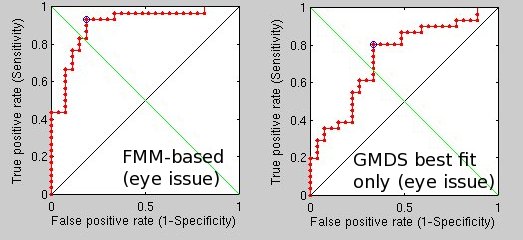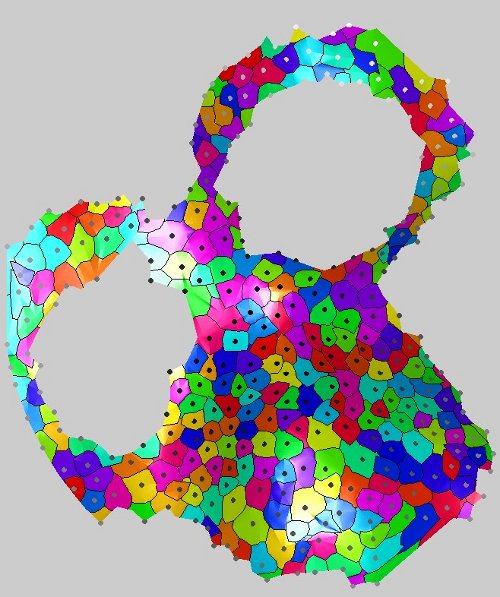Archive for March, 2012
Random Positions in GMDS- and FFM-based Analysis
 he latest batch of experiments looked at how one might cope with a mask closer than usual to the eye’s centre. I used harder pairs.
he latest batch of experiments looked at how one might cope with a mask closer than usual to the eye’s centre. I used harder pairs.
It did not work too well. One remaining limitation is that in an attempt to determine fiducial-esque points based on unmarked (not annotated) 3-D data there is little other than the nose tip that can consistently and accurately be pinned down. The eyes in particular are not simple to segment in 3-D — not without some help from 2-D anyway — mostly because the corners are fuzzy in 3-D. While slight head rotations can be annulled with ICP, there is still a difficulty associated with true distances as measured based on the range images. Accurately-measured geodesic distances are supposed to be robust to that, but in practice when there is slight rotation difference some of the calculations don’t add up. The sensitivity to inherent differences is often outweighed by pose.

Classification mistakes were partly caused by hair, occlusion, and other factors. I have rerun the same experiments as before with twice the number of vertices, but unsurprisingly, the results were about the same. The excessive detail gains never brought much improvement in terms of verification performance. Next, I took the best approach of the bunch and ran it on some of the hardest cases. The ROC curve is shown while for simpler cases the experiment is still being run on two servers.
There’s still no hope of beating state-of-the-art performance levels, unless of course a significantly improved variant is found.
Some of the problems are easier for the human eye to see, such as cases where hair penalises the scoring mechanism, as shown in the picture below.


Random points were then attempted, adding a stochastic nature to this problem. In order to make GMDS ‘fail’ most badly only in the case of false pairs, I have tested some new masks and measured verification performance reached by using them. For GMDS it failed quite badly, but with the other FMM-based approach — applied to some hard cases — I got the results shown in the ROC curve. Rather than dilating the masks and varying the hole sizes I would like to try varying positions from which to dilate in order to sample more distinct regions and measure distances upon those. This seems like an approach with real potential, provided the random (or fixed) sample of points is large enough to compensate for noise/intra-person variation. The latest experiment was preparatory towards this approach.




Random positions were further tested by making a variation, an improvement to the above. By letting the anchor points move around a bit (randomly within range) I was unable to get better performance than before (just over 90% verification rate on hard cases too). There are other methods that I could try next…

120 random positions were then placed on pairs to further test the approach. These further attempts to improve performance by moving points randomly (and this time taking a larger random sample) were not quite so successful. The general premise was, by taking many points around the face and expanding from them (with geodesic means) will lead to a good and rather unique signature. In practice, however, the measure is insensitive to real anatomical differences. Intra-person differences can outweigh inter-person differences. I’ll try another approach, but it will take days for results to arrive.

Although this is being tested on faces at the moment, the methods are generalisable and can be applied to any biomedical data for similar purposes.
Using a Phone Anonymously in the UK

 HOSE WHO KNOW history will appreciate the importance of civil rights. Those who saw the Berlin Wall built will possibly recall all that was learned about the Stasi for example.
HOSE WHO KNOW history will appreciate the importance of civil rights. Those who saw the Berlin Wall built will possibly recall all that was learned about the Stasi for example.
In this age of crackdown on journalism and on civil liberties in the UK (simply censorship and gagging) we ought to be aware of the power of those who run the country. They are very rich people. The surveillance gives them more power. While CCTV is impossible to dodge, phones are not obligatory for most people. Phones are surveillance devices, but phones has other features, calls included. Those entice people into carrying tracking devices (walking along with them) and always leaving those switched on, with an identity attached to them (just like a landline). There are other problems with mobile phones.
I have several mobile numbers and phones, but they do not come with tracking per se, as with pay as you go (PAYG) in the UK it turns out that it is possible — albeit hard — to purchase and use a phone anonymously (unless someone works hard to decipher the identity). Here is what I found in each major shop:
Carphone Warehouse: always must disclose personal details, no matter the network, phone, plan, and payment method
Orange: must give personal details to the cashiers
Vodafone: needn’t give personal details, can pay with cash
Phone4U: need to pay more for anonymous usage
Virgin: can avoid giving personal details, but there are caveats
To the credit of all the above, no store had people working for it who give a ‘funny’ or ‘dirty’ look when asked about privacy implications, maybe because I don’t look like a terrorist or maybe because I’m exceedingly polite and smile all the time. Either way, it is not as bad as it could be. To ask for privacy these days is almost like confessing to doing something malicious.
UK Censorship
 AR CRIMES are considered a lot less serious than whistle-blowing, according to UK standards. The government is currently trying to suppress the publication of stuff that should have been public all along. It is very sad to see that once again — as expected — much of the public will neither know nor care. And why? Because “censorship” is perceived as bad only as long as “they” do it, not “us”. A lot of people are brainwashed into the mindset that our own censorship is “defending” us and others’ is “suppressing” them.
AR CRIMES are considered a lot less serious than whistle-blowing, according to UK standards. The government is currently trying to suppress the publication of stuff that should have been public all along. It is very sad to see that once again — as expected — much of the public will neither know nor care. And why? Because “censorship” is perceived as bad only as long as “they” do it, not “us”. A lot of people are brainwashed into the mindset that our own censorship is “defending” us and others’ is “suppressing” them.
Richard Stallman got it right about censorship. All censorship is bad. If we go down the slippery slope of selective and hypocritical censorship but never stand up, we deserve the consequences.
Topological Mistakes in GMDS
 n particular cases, GMDS failures (topological mistakes) continue to be a problem, but it is possible to detect whether that happens and then just filter those cases away. Having run experiments that try to overcome these occasional failures, I got nearly flawless classification with the FMM-based methods when it’s applied to simpler pairs, less successful when dealing with harder cases (an order of magnitude more failures, as shown in the ROC curve).
n particular cases, GMDS failures (topological mistakes) continue to be a problem, but it is possible to detect whether that happens and then just filter those cases away. Having run experiments that try to overcome these occasional failures, I got nearly flawless classification with the FMM-based methods when it’s applied to simpler pairs, less successful when dealing with harder cases (an order of magnitude more failures, as shown in the ROC curve).

In order to reduce the recurrence of failures I am varying the size of the holes and the overall surface area, noting that still, even for corresponding surfaces, there are sometimes cases of GMDS failure.



More ROC curves were learned thereafter. Dealing yet again with cases that are hard, the following results were obtained by making further changes to the masks, even though ongoing experiments look at a wider range of attempts, over which a best fit or average get taken. By mixing the more successful approaches, better rates can be assured. By adding the simpler pairs, better rates can also be assured.

James Randi Versus Charlatans in Australia
From this video description: “Due to the deactivation of “google videos” (i guess becose youtube is acepting long videos and google wants to keep all the vids over here) A lot of precious videos are being deleted in the next few days!”






 Filed under:
Filed under: 
